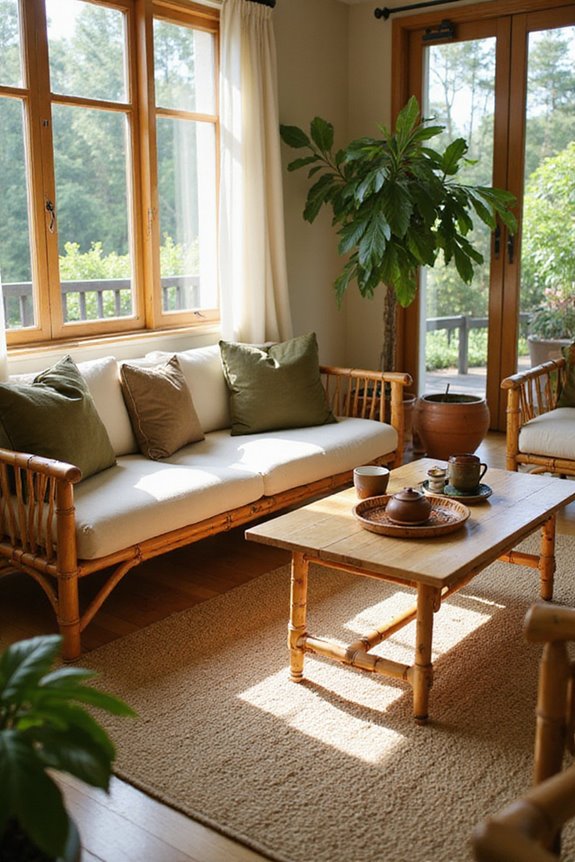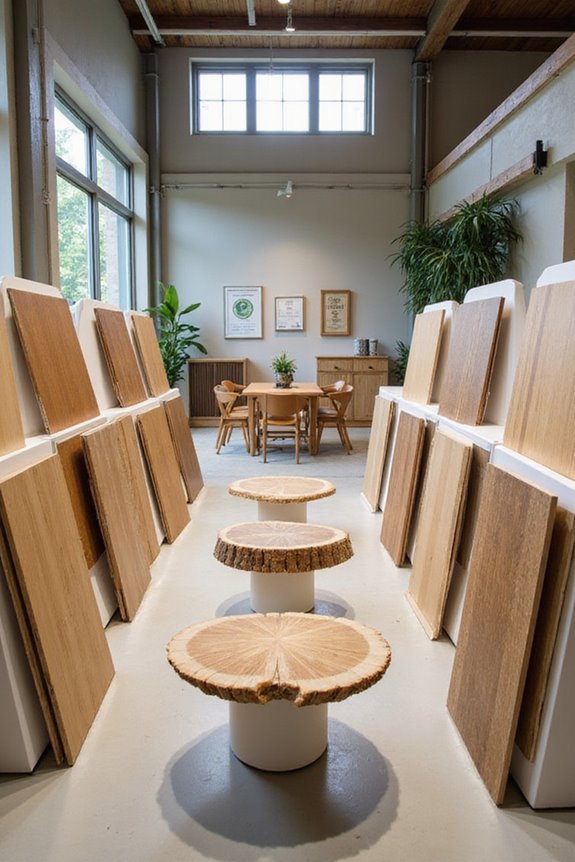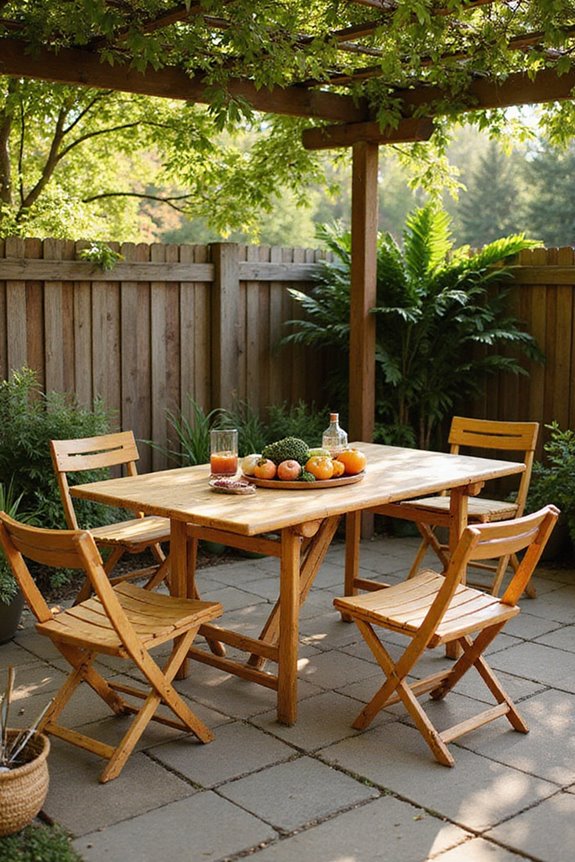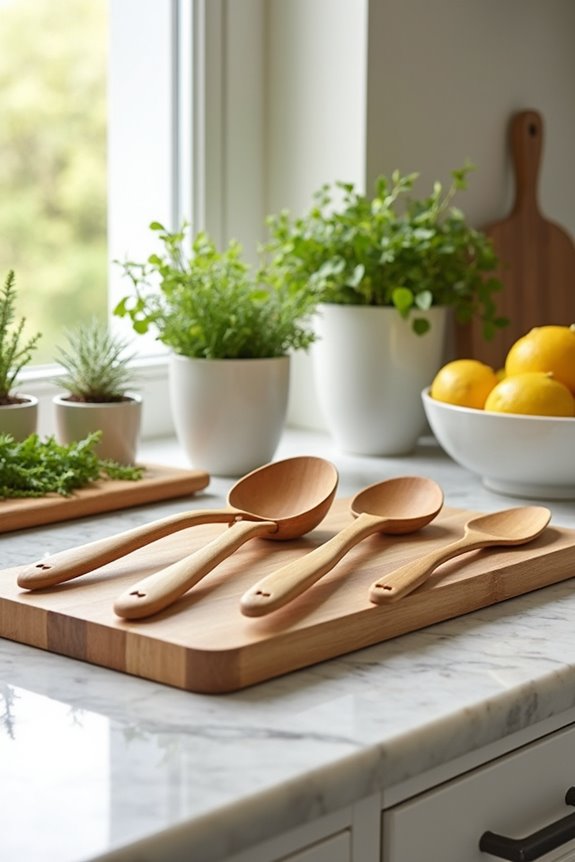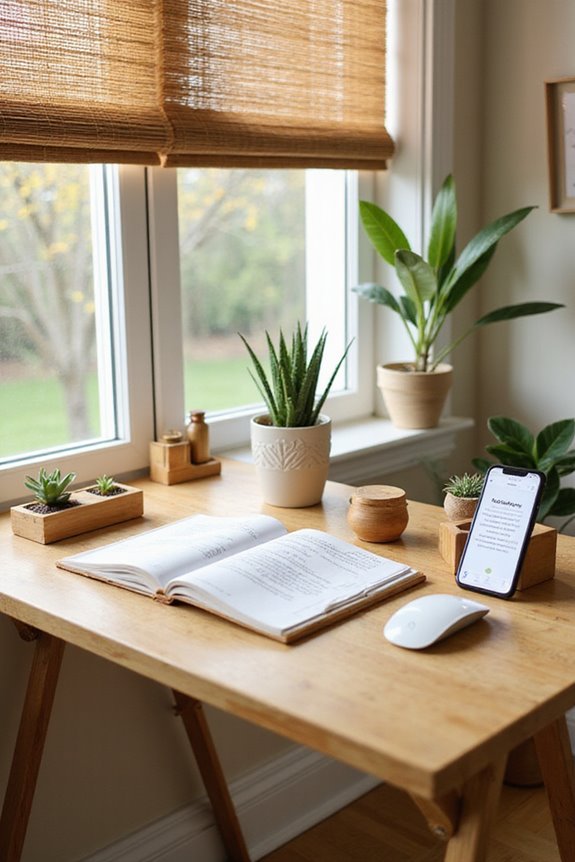Bamboo furniture is made from the fast-growing bamboo plant, known for its strength and lightness. This eco-friendly option is durable and versatile, making it suitable for multiple styles, from traditional to modern. With its natural resistance to pests and moisture, bamboo requires low maintenance. Plus, its sustainability features include rapid regrowth and low CO2 emissions during production. If you stick with us, we’ll explore more about its design applications and advantages.
Key Takeaways
- Bamboo furniture is crafted from bamboo, a strong and durable grass known for its lightweight properties and high tensile strength.
- It is an eco-friendly alternative to traditional wood, maturing in just 3-5 years and naturally regrowing without replanting.
- Bamboo furniture is resistant to moisture and pests, making it suitable for high-traffic areas while requiring minimal maintenance.
- Versatile in design, bamboo furniture can be styled in both traditional and modern aesthetics, often incorporating innovative weaving techniques.
- The bamboo furniture market is growing rapidly, supporting local economies and promoting sustainable practices that benefit the environment.
Characteristics of Bamboo as a Material
When we consider bamboo as a material, it’s clear that its unique characteristics make it exceptional for furniture and construction. First, bamboo density ranges from about 0.4 to 0.8 g/cm³, which gives it a lightweight nature. This low density allows for easier handling and transportation compared to heavier woods.
Next, bamboo strength is impressive, as it exhibits high tensile strength, sometimes surpassing steel. This means bamboo can withstand tension and bending forces effectively.
Finally, its natural structure combines solid and hollow culms, balancing lightness and strength. These characteristics make bamboo an ideal choice for those of us looking for reliable and sustainable materials in our homes. Embracing bamboo furniture is a step toward creating a welcoming space. Additionally, bamboo is a rapidly renewable resource that grows up to 3 feet daily, making it an environmentally responsible choice.
Sustainability Features of Bamboo Furniture
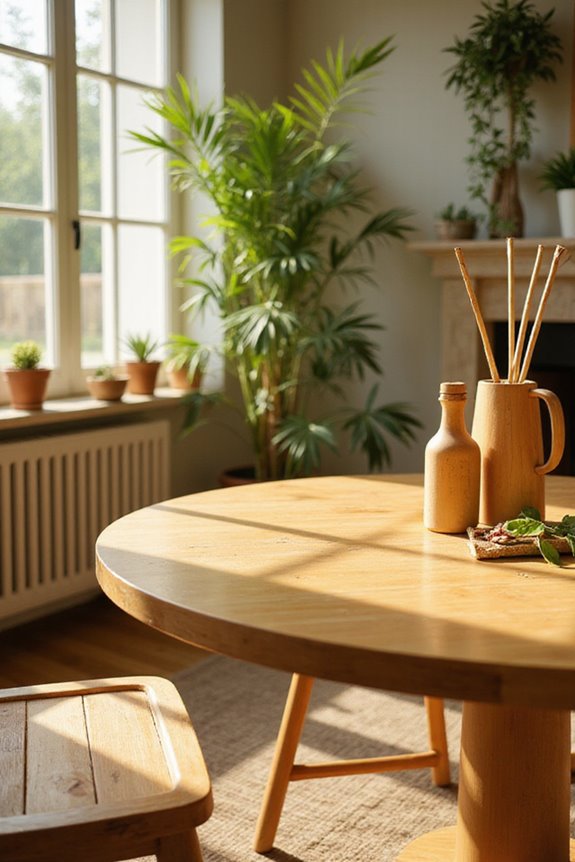
Bamboo furniture stands out for its impressive sustainability features, making it a smart choice for eco-conscious consumers. First, bamboo cultivation is remarkably efficient. It matures in just 3-5 years and regrows without needing replanting. This rapid renewability helps reduce pressure on our forests.
Second, bamboo plays an essential role in carbon sequestration. It absorbs more carbon dioxide than many plants, contributing to a healthier atmosphere. Additionally, bamboo’s natural pest resistance means fewer pesticides are needed, fostering better ecosystems.
Finally, bamboo furniture is biodegradable, minimizing landfill waste. It supports a circular economy by being repurposable and recyclable. By choosing bamboo, we’re actively participating in protecting our planet’s resources and promoting sustainability. Moreover, properly treated bamboo resists pests and decay, enhancing its longevity and overall environmental impact.
Practical Advantages of Using Bamboo
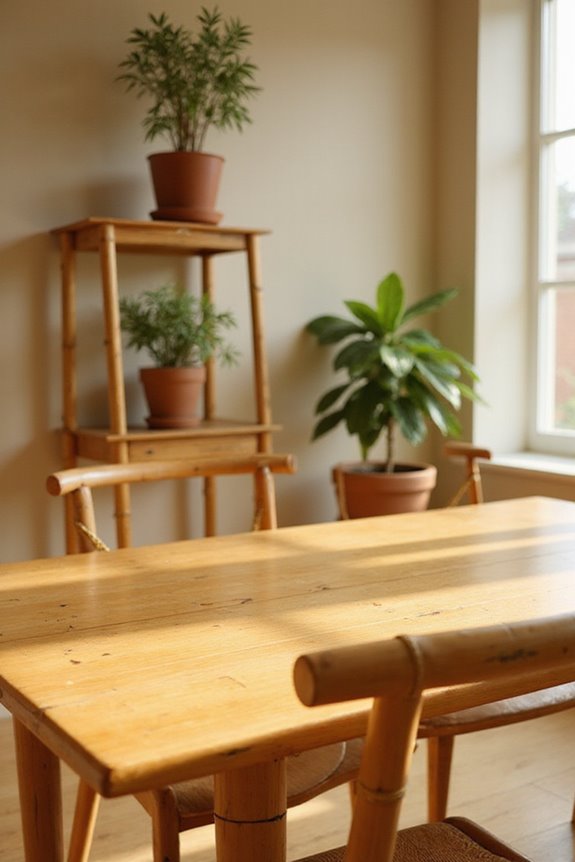
One of the key reasons many of us choose bamboo furniture is its impressive durability and strength. Bamboo has tensile strength greater than steel, making it ideal for various furniture applications. It resists moisture and insects, ensuring longevity in high-traffic areas.
Moreover, bamboo furniture is low maintenance. It’s easy to clean and resistant to stains, perfect for busy kitchens or bathrooms.
Cost-effectiveness is another benefit; bamboo is often more affordable than hardwood options. Its lightweight nature also reduces shipping costs.
Lastly, bamboo’s aesthetic appeal and ergonomic design enhance our living spaces. With its natural beauty and comfort, bamboo furniture can truly bring a sense of belonging to our homes while being practical and stylish. Additionally, its sustainable sourcing contributes to environmental conservation efforts, making it a responsible choice for eco-conscious consumers.
Design Applications for Bamboo Furniture
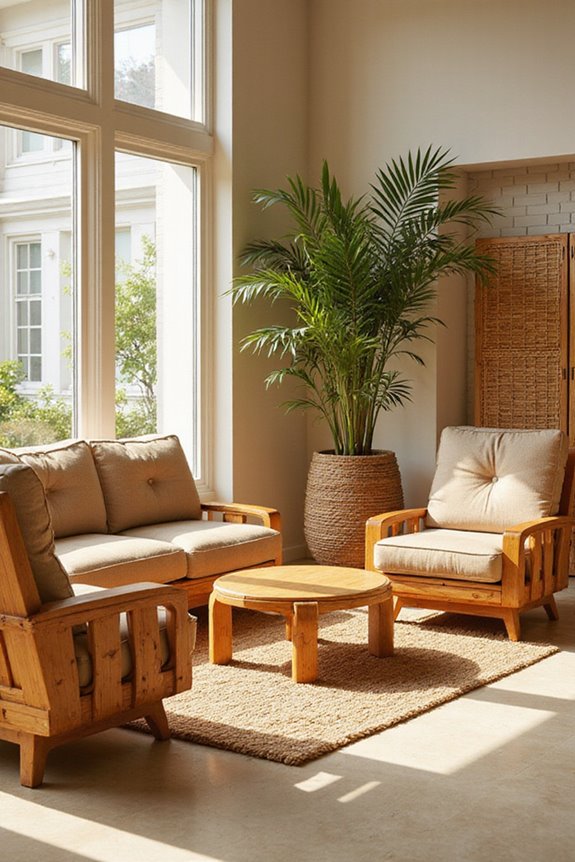
Design applications for bamboo furniture showcase its versatility in both traditional and modern styles. We can see how bamboo aesthetics come to life through various weaving techniques. For instance, flat bamboo weaving creates stable tabletops and cabinet doors, while curved weaving offers softer chair backrests. These designs not only enhance visual texture but also reflect cultural identities.
- Traditional and Modern Fusion
- Bamboo weaving integrates with other materials, enriching aesthetics.
- Three-dimensional weaving forms bring fresh appeal to furniture.
- Bamboo screens serve as effective room dividers.
- Innovative designs expand bamboo’s range, making it suitable for any space. Additionally, the eco-friendly choice of bamboo furniture reflects a commitment to sustainability, appealing to environmentally conscious consumers.
Care and Maintenance of Bamboo Furniture
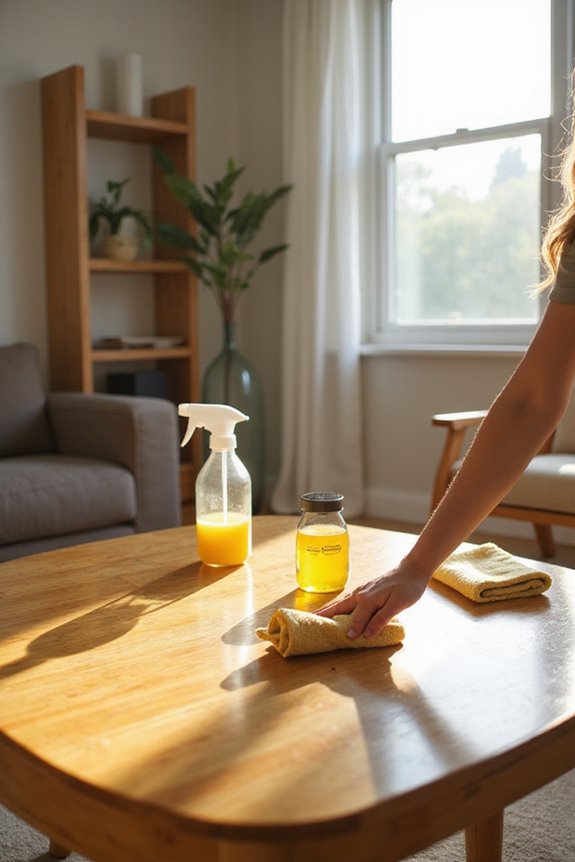
Taking care of bamboo furniture is essential to guarantee its longevity and maintain its beauty. Here are some effective cleaning techniques to follow:
- Use a soft microfiber cloth to remove dust gently.
- For hard-to-reach spots, employ soft-bristled brushes.
- Mix mild dish soap with warm water for cleaning solutions.
Wipe along the grain to prevent water damage.
For maintenance, we recommend conditioning the surface once or twice a year. Use commercial bamboo conditioner or natural options like white vinegar. Additionally, regular application of bamboo oil helps preserve the natural luster of the furniture.
Avoid abrasive cleaners and make sure we clean spills promptly. Also, check for mold and treat it carefully. Following these maintenance tips will help keep our bamboo furniture looking great and lasting longer.
Economic and Environmental Impact
The economic and environmental impact of bamboo furniture is significant, especially as we face growing concerns about sustainability. This market, valued at over USD 11 billion, is projected to grow substantially, driven by rising consumer demand for eco-friendly options. Such economic growth supports employment in farming, processing, and retail.
Additionally, bamboo’s rapid renewability offers remarkable environmental conservation benefits. It grows quickly and requires fewer pesticides, reducing soil degradation. Bamboo furniture production also emits less carbon dioxide compared to traditional materials. By choosing bamboo, we help lessen deforestation pressures and promote biodiversity. Moreover, the sustainable materials used in bamboo furniture align with eco-conscious choices, enhancing its appeal to environmentally aware consumers.
Comparing Bamboo to Traditional Materials
When we compare bamboo to traditional materials like solid wood, we notice several important differences. First, bamboo durability has improved markedly. Modern strand-woven bamboo can be harder than oak or ash, yet it may still face issues with moisture. In contrast, solid wood has natural integrity, making it more resilient over time.
Second, bamboo aesthetics appeal to many due to its unique look and eco-friendly qualities. However, the laminated structure can create weaknesses compared to the uniformity of solid wood.
Lastly, bamboo is often more affordable than high-quality hardwoods, yet it may not hold its value as well in the long run. Understanding these differences helps us make informed choices for our homes.
Popular Styles and Trends in Bamboo Furniture
Bamboo furniture is making a strong comeback as we embrace modern design trends. Today, it fits beautifully into various styles, showcasing bamboo aesthetics and versatility. For instance:
- Japandi Style: Integrates bamboo for a minimalist and cozy feel, often with neutral cushions.
- Bohemian Interiors: Utilizes bamboo’s natural texture to add warmth and eclectic charm.
- Minimalist Designs: Focus on clean lines and functional forms, highlighting bamboo’s subtle warmth.
- Maximalist Decor: Combines bamboo with bold colors and patterns for striking contrasts.
Bamboo’s durability and lightweight nature allow it to serve multiple purposes, from dining chairs to storage units. As we seek sustainable options, bamboo furniture aligns perfectly with our eco-conscious values, proving it’s both functional and stylish in today’s homes.
Frequently Asked Questions
Is Bamboo Furniture Resistant to Pests and Insects?
We’ve often wondered about bamboo’s pest resistance, and while it shows some insect durability, it still needs proper care. Moisture and treatment play essential roles in ensuring our bamboo furniture stays protected from pesky invaders.
Can Bamboo Furniture Be Used Outdoors?
Yes, we can use bamboo furniture outdoors! With proper outdoor maintenance and attention to bamboo durability, we’ll guarantee it withstands the elements while enjoying its unique charm in our outdoor spaces. Let’s keep it protected!
How Does Bamboo Furniture Compare in Price to Hardwood Furniture?
When it comes to bamboo pricing, it’s like finding treasure compared to hardwood comparison! We’ve discovered bamboo’s affordability often beats high-end hardwood, making it a perfect choice for those of us seeking budget-friendly sustainability.
What Finishes Are Available for Bamboo Furniture?
When considering bamboo finishes, we often appreciate their durability and aesthetic appeal. For bamboo maintenance, choosing the right finish helps us protect our furniture while enhancing its natural beauty, making it a worthwhile investment.
Are There Any Health Concerns Associated With Bamboo Furniture?
Oh, the joys of bamboo furniture! While it’s stylish, we’ve gotta watch out for bamboo toxicity concerns and those pesky bamboo furniture allergies. Let’s choose wisely and keep our homes safe and toxin-free together!

